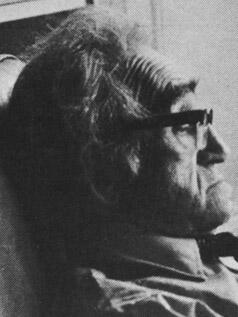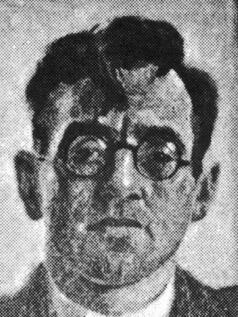
 Jack
Coia was christened Giacomo Antonio Coia. He was born in Salop Street, Wolverhampton
on 17 July 1898 and was the eldest of nine children. His father was Giovanni Coia,
a farmer's son, who became a sculptor and later a café owner near Parkhead
Cross in Glasgow. Jack's wife was Maria Ernesta who was a circus artist and dancer.
Jack graduated from the Glasgow School of Art in 1923. After a short period in
London he returned to Glasgow where he lectured at the School of Art. Later he
became a partner in the firm of Gillespie, Kidd and Coia and designed the Palace
of Industry and the Roman Catholic Pavilion for the Empire Exhibition at Bellahouston
Park, Glasgow in 1938. Renowned for his many church designs, he received three
medals from the Royal Institute of British Architects. In October 1967, the Queen
made Jack Coia a Commander of the British Empire. Jack Coia died in Glasgow on
4 August 1981.
Jack
Coia was christened Giacomo Antonio Coia. He was born in Salop Street, Wolverhampton
on 17 July 1898 and was the eldest of nine children. His father was Giovanni Coia,
a farmer's son, who became a sculptor and later a café owner near Parkhead
Cross in Glasgow. Jack's wife was Maria Ernesta who was a circus artist and dancer.
Jack graduated from the Glasgow School of Art in 1923. After a short period in
London he returned to Glasgow where he lectured at the School of Art. Later he
became a partner in the firm of Gillespie, Kidd and Coia and designed the Palace
of Industry and the Roman Catholic Pavilion for the Empire Exhibition at Bellahouston
Park, Glasgow in 1938. Renowned for his many church designs, he received three
medals from the Royal Institute of British Architects. In October 1967, the Queen
made Jack Coia a Commander of the British Empire. Jack Coia died in Glasgow on
4 August 1981.Today we are drawn together
in the human sadness of loss; the loss of a man of rare talent, and of great simplicity.
But our coming together is not merely to remember and to mourn, but to grow in
hope and to commend the great soul of Jack Coia to the love of God. I speak with
a sense of privilege. As a priest I speak for the Church and for the faith which
was Jack's. I speak too as an architect, a pupil of that renowned practice of
Gillespie, Kidd and Coia, and I speak as a friend; for those 31 years of my acquaintance
could only serve to increase an admiration and affection. I like to think, too,
that Jack would be pleased. He was a little proud of the "office priest"
and he would tip me a pound like a kindly uncle when, in my mid-thirties, I approached
my ordination and came to visit. My first meeting with Archbishop Scanlon, the
former Archbishop of Glasgow, was in Rome in 1970. He asked my name, and on telling
him, he responded "Oh yes, Coia's boy". And I have shamelessly traded
on the name; it stands high among architects, whose laurels are not lightly granted
to their fellows. Jack had a child-like love of appreciation, never quite seeming
to realise that the honours were rightly his, and they were many, and never quite
seeming to realise that these honours represented would live on in the buildings
which bear his inimitable seal. This is a time for epitaphs and I am sure that
Wren himself would not begrudge a share in his. "If you seek a memorial,
look about you" for here in Glasgow and the West of Scotland and beyond are
many evidences of a skill and an artistry which span the fifty-seven years since
he first qualified in 1924 and which span other, crucial years too; the early
struggles following those brilliant student years; the war years with all their
frustrations; the emergence of modern architecture, and the profound impact of
the Second Vatican Council. He met them and found their measure. I say this to
show that Jack was a great architect and a great Scottish architect whose interpretative
vision enlivened the Scottish scene with something of the brilliance of the Italian
sun. But that greatness stemmed not only from his native talent but also from
that simplicity and that humility which was open to new and exciting visions;
for it was only his courage which brought that talent to the fore and his faith
which gave him courage and sustained that simplicity of heart. His Catholic faith
was an integral part of his whole personality; he wore it unostentatiously and
he conveyed its depth in his work. He loved the Church, and to enhance it was
the essential delight of his life. His many churches, principally in the West
of Scotland, begin with Saint Anne's, Whitevale Street and end with Our Lady of
Good Counsel in Craigpark Street; two of the fine churches of Europe, and there
they stand, parish churches in Dennistoun, Glasgow, vital in every detail. He
built like the good architect of the first reading (I Corinthians 3:10); and like
Saint Paul, others continue to build on these foundations. Maybe it was because
only the best was good enough for Jack that I found the seeds of my own calling.
Isi Metzstein, old colleague and Jack's partner once said: "I confess that
architecture is a sort of priesthood" and for my part I have never found
the two professions incompatible. "Others continue to build" and how
proud Jack would have been to read the accolade accorded to Gillespie, Kidd &
Coia in this current Architectural Review in speaking of the new Robinson College
as worthy of the great building tradition of Cambridge. The exciting years of
the fifties when the atelier, rather than the office of Jack Coia in Waterloo
Street was a ferment of youthful ideas and enthusiasms, enlivened by the Maestro
himself, have not betrayed his confidence. But that is only part and I think for
Jack, the lesser part of the building which goes on upon his foundations. He was
glad and a little proud of the priest and the professor and the others, the honours
too; but even more was he glad and now in God's loving kindness he must surely
know of that building up of countless ordinary people whose faith was deepened
by the perception of a beauty which he unfolded in the setting of their worship.
Good architecture is essentially simple, and the great architect is one who has
avoided the conceits which imperil his art. Good architecture embodies the qualities
of faith; commodity, firmness and delight are incorporated by Saint Paul in the
dwelling place of God in the Spirit, which he describes to the Ephesians in the
second reading (Ephesians 2:19-22). They are the criteria of good architecture
and delight is simple and unalloyed harmony. Jack's churches encouraged and inspired
many other architects and the quality of his churches as architecture ranked with
the best secular work and gave new meaning to a living faith which could inspire.
If architecture is about human life and its expression of that life, it is also
about aspiration, for it should contain the seeds of the fulfilling of that aspiration.
The Church in the West of Scotland is immeasurably richer for Jack Coia's work,
and those churches are valued beyond the confines of these dioceses; but Oxford,
Cambridge, Hull and Glasgow Universities number colleges and work by Gillespie,
Kidd and Coia; and elsewhere, schools, hospitals, colleges and housing, numerous
commissions, are an eloquent testimony in themselves. Yet often, too, financial
strictures, changing patterns in the Church, and other circumstances stepped in
to blur the fine achievement. But they were part of the agony of a good soul and
they kept him the man he always was. My last and happy meeting with Jack Coia
was at Glendaruel, when the man who then celebrated his eightieth birthday those
three short years ago would still run by the lochside, cared for a small job on
one of his early churches, Saint Peter in Chains at Ardrossan and clearly revelled
in that glorious combination of family and friends, bagpipes and an abundance
of good Italian lambrusco. The days are passed now, but the family and the friends
and the love remain. He wanted to be buried from this church; he began here, nothing
of his is visible. And so he finally put everything aside, and with his mother's
crucifix in his hands, he turned to the Lord alone; the ultimate simplicity and
the final goal. The sign has given way to the reality. May he rest in peace.